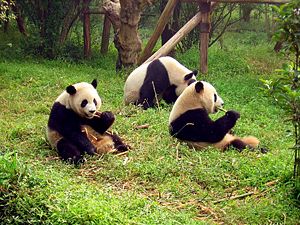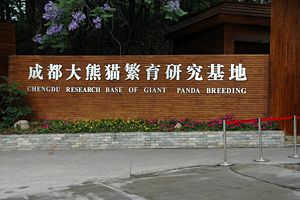Difference between revisions of "Sichuan Giant Panda Sanctuaries" - New World Encyclopedia
Dan Davies (talk | contribs) |
Dan Davies (talk | contribs) (→External links: checked) |
||
| Line 87: | Line 87: | ||
== External links == | == External links == | ||
| − | * [http://whc.unesco.org/en/list/1213 UNESCO description of the site] | + | * [http://whc.unesco.org/en/list/1213 UNESCO description of the site]. Retrieved June 11, 2008. |
| − | * [http://www.pandaclub.net/ Wolong Panda Club] | + | * [http://www.pandaclub.net/ Wolong Panda Club]. Retrieved June 11, 2008. |
| − | * [http://www.ifrance.com/pandageant/ Pandas !] | + | * [http://www.ifrance.com/pandageant/ Pandas!]. Retrieved June 11, 2008. |
| − | * [http://www.chinawolong.com Official | + | * [http://www.chinawolong.com Wolong National Nature Reserve Official Site]. Retrieved June 11, 2008. |
| − | * [http://www.youtube.com/watch?v=N3lQdLTBXNU&eurl= Giant panda cubs at Wolong National Nature Reserve] | + | * [http://www.youtube.com/watch?v=N3lQdLTBXNU&eurl= Giant panda cubs at Wolong National Nature Reserve]. Retrieved June 11, 2008. |
| − | * [http://www.pandaclub.net/ Wolong Panda Club] | + | * [http://www.pandaclub.net/ Wolong Panda Club]. Retrieved June 11, 2008. |
| − | * [http://www.pandaclub.nl/ Dutch informational website about Wolong] | + | * [http://www.pandaclub.nl/ Dutch informational website about Wolong]. Retrieved June 11, 2008. |
| − | * [http://www.panda.org.cn/english/index.htm Chengdu Panda Base home page] | + | * [http://www.panda.org.cn/english/index.htm Chengdu Panda Base home page]. Retrieved June 11, 2008. |
{{World Heritage Sites in China}} | {{World Heritage Sites in China}} | ||
Revision as of 18:49, 11 June 2008
| Sichuan Giant Panda Sanctuaries* | |
|---|---|
| UNESCO World Heritage Site | |

| |
| State Party | |
| Type | Natural |
| Criteria | x |
| Reference | 1213 |
| Region** | Asia-Pacific |
| Inscription history | |
| Inscription | 2006 (30th Session) |
| * Name as inscribed on World Heritage List. ** Region as classified by UNESCO. | |
The Sichuan Giant Panda Sanctuaries (Simplified Chinese: 四川大熊猫栖息地; Traditional Chinese: 四川大熊貓棲息地; pinyin: Sìchuān Dàxióngmāo Qīxīdì) located in southwest Sichuan province of China, is the home to more than 30% of the world's highly endangered Giant Pandas and is among the most important sites for the captive breeding of these pandas. It covers 9245 km² with seven nature reserves and nine scenic parks in the Qionglai and Jiajin Mountains. Along with the Giant Panda, the sanctuary is a refuge to other endangered species such as the red panda, the snow leopard, and the clouded leopard. Outside of the tropical rainforests, it is among the botanically richest sites of the world, and is home to between 5,000 and 6,000 species of flora. It has been noted that the region is similar to the paleo-tropic forests of the Tertiary Era.
The Sichuan Giant Panda Sanctuaries consist of seven nature reserves and nine scenic parks.
Seven Nature Reserves
- Wolong National Nature Reserve|Wolong Nature Reserve (Chinese: 卧龙自然保护区)
- Fengtongzhai Nature Reserve (Chinese: 蜂桶寨自然保护区)
- Mt. Siguniang Nature Reserve (Chinese: 四姑娘山自然保护区)
- Laba River Nature Reserve (Chinese: 喇叭河自然保护区)
- Heishui River Nature Reserve (Chinese: 黑水河自然保护区)
- Jintang-Kongyu Nature Reserve (Chinese: 金汤—孔玉自然保护区)
- Caopo Nature Reserve (Chinese: 草坡自然保护区)
Wolong National Nature Reserve
Coordinates: Wolong National Nature Reserve (Simplified Chinese: 卧龙自然保护区; Traditional Chinese: 臥龍自然保護區) is a protected area located in Wenchuan County, Sichuan Province, People's Republic of China. Established in 1963, the reserve covers an area of about 200,000 hectares. There are over 4,000 different species recorded in the reserve.[1] Wolong National Nature Reserve houses more than 150 highly endangered giant pandas.
In June 1980, the China Conservation and Research Center for the Giant Panda was established at Wolong with the efforts of both World Wildlife Fund (WWF) and the Chinese government. To this date, researchers have conducted many breeding research on giant pandas and have successfully bred 66 panda cubs.[1]
A mountain stream runs through the Wolong Valley (where the Reserve is); the stream is heavily armoured with boulders and smaller rounded stones. Stream waters are rather alkaline with pH levels in the range of 8.91. (Hogan, 2007) Water quality turbidity is quite high due to extensive sand and gravel mining in stream.[2]
According to a 2001 research by Dr. Jianguo Liu of Michigan State University, the rate of destruction is higher after the reserve's creation than before its creation. Using NASA's satellite images and records of population, Liu's research team concluded that due to tourism and the increase in local population, the reserve is facing an unprecedented threat. "Tourists don't think they have an impact on panda habitat, but indirectly each visitor has some impact," Liu said. "We don't see ourselves as a destructive force, but we are."[3]
The region, including the Panda Research Center, has been largely devastated on 12 May 2008 by a catastrophic earthquake, though the captive giant pandas are reported to be safe.[4][5] Initially, officials were unable to contact the reserve.[6] However, PRC’s Foreign Ministry later said that a group of 31 British tourists visiting the Wolong panda reserve in the quake-hit area have returned safe and uninjured to the provincial capital. Nonetheless, the well-being of an even greater number of pandas in the neighbouring panda reserves remains unknown initially. Five security guards at the reserve were killed by the earthquake.[7] Six pandas escaped after their enclosures were damaged. By May 20, two pandas at the reserve were found to be injured, while the search continued for another two adult pandas that went missing after the quake.[8] By 28 May 2008, one panda was still missing.[9] The missing panda was later found dead under the rubble of an enclosure.[10] Sadly, nine-year-old Mao Mao, a mother of five at the breeding centre, was discovered on Monday, her body crushed by a wall in her enclosure. Panda keepers and other workers placed her remains in a small wooden crate and buried her outside the breeding centre.
Nine Scenic Parks
- Mt. Qingcheng-Dujiangyan Scenic Park (Chinese: 青城山—都江堰风景名胜区)
- Mt. Tiantai Scenic Park (Chinese: 天台山风景名胜区)
- Mt. Siguniang Scenic Park (Chinese: 四姑娘山风景名胜区)
- Xiling Snow Mountain Scenic Park (Chinese: 西岭雪山风景名胜区)
- Mt. Jiguan-Jiulonggou Scenic Park (Chinese: 鸡冠山—九龙沟风景名胜区)
- Mt. Jiajin Scenic Park (Chinese: 夹金山风景名胜区)
- Miyaluo Scenic Park (Chinese: 米亚罗风景名胜区)
- Mt. Lingzhen-Mt. Daxue Scenic Park (Chinese: 灵鹫山—大雪峰风景名胜区)
- Mt. Erlang Scenic Park (Chinese: 二郎山风景名胜区)
Chengdu Research Base of Giant Panda Breeding
Chengdu Research Base of Giant Panda Breeding, or simply Chengdu Panda Base, is a non-profit research and breeding facility for giant pandas and other rare animals. It is located in Chengdu, Sichuan, People's Republic of China.
Chengdu Panda Base was founded in 1987. It started with 6 giant pandas that were rescued from the wild. By 2007, it has had 110 panda births, and the captive panda population has grown to 62[1].
Its stated goal is to "be a world-class research facility, conservation education center, and international educational tourism destination."[1]
Partnerships
Chengdu Panda Base has partnered with many organizations in improving ways to conserve giant pandas. For example, its partnereship with Zoo Atlanta helped the zoo secure the loan of 2 giant pandas.[11]. To date, these 2 giant pandas, Yang Yang and Lun Lun, have produced one off-spring at the zoo.
Other research partners include[12]:
- Adventure World in Shirahama, Wakayama, Japan
- East Bay Zoological Society, Oakland, California, USA
- Liverpool University, UK
- National Institute of Health/National Cancer Institution, USA
- National Zoo, Washington, D.C., USA
- North of England Zoological Society, UK
- The Oakland China Wildlife Preservation Foundation, California, USA
- San Diego Zoo, California, USA
- University of Japan
See also
- Panda
- Captive breeding
Notes
- ↑ 1.0 1.1 1.2 1.3 About Wolong, Wolong National Natural Reserve. Cite error: Invalid
<ref>tag; name "about" defined multiple times with different content - ↑ Hogan, C.M., Lumina Tech, Environmental analysis of the Wolong National Nature Reserve (2007)
- ↑ (April 6, 2001). Endangered Pandas Not Safe in Chinese Nature Reserve, Environment News Service.
- ↑ (May 14, 2008). [1], Pandas International.
- ↑ (May 13, 2008). [2], Pandas 'safe' at park after quake.
- ↑ "Report: Rare giant pandas at Chinese breeding center safe after quake", International Herald Tribune, 2008-05-13. Retrieved 2008-05-20.
- ↑ Liu, Melinda, "Animal Instinct", China Earthquake, Newsweek, 2008-05-21. Retrieved 2008-06-10.
- ↑ "Two pandas missing in China quake region", UPI, 2008-05-20. Retrieved 2008-05-20.
- ↑ Associated Press. "Panda reserve mulls moving after quake damage", CNN, 2008-05-29. Retrieved 2008-05-29.
- ↑ Yan, Yangtze, "One panda confirmed dead in China quake", Window of China, Xinhua News Agency, 2008-06-10. Retrieved 2008-06-10.
- ↑ Zoo Atlanta's Conservation Education Initiative in China.
- ↑ Research partners.
ReferencesISBN links support NWE through referral fees
External links
- UNESCO description of the site. Retrieved June 11, 2008.
- Wolong Panda Club. Retrieved June 11, 2008.
- Pandas!. Retrieved June 11, 2008.
- Wolong National Nature Reserve Official Site. Retrieved June 11, 2008.
- Giant panda cubs at Wolong National Nature Reserve. Retrieved June 11, 2008.
- Wolong Panda Club. Retrieved June 11, 2008.
- Dutch informational website about Wolong. Retrieved June 11, 2008.
- Chengdu Panda Base home page. Retrieved June 11, 2008.
| |||||||
Credits
New World Encyclopedia writers and editors rewrote and completed the Wikipedia article in accordance with New World Encyclopedia standards. This article abides by terms of the Creative Commons CC-by-sa 3.0 License (CC-by-sa), which may be used and disseminated with proper attribution. Credit is due under the terms of this license that can reference both the New World Encyclopedia contributors and the selfless volunteer contributors of the Wikimedia Foundation. To cite this article click here for a list of acceptable citing formats.The history of earlier contributions by wikipedians is accessible to researchers here:
- Sichuan_Giant_Panda_Sanctuaries history
- Wolong_National_Nature_Reserve history
- Chengdu_Research_Base_of_Giant_Panda_Breeding history
The history of this article since it was imported to New World Encyclopedia:
Note: Some restrictions may apply to use of individual images which are separately licensed.

